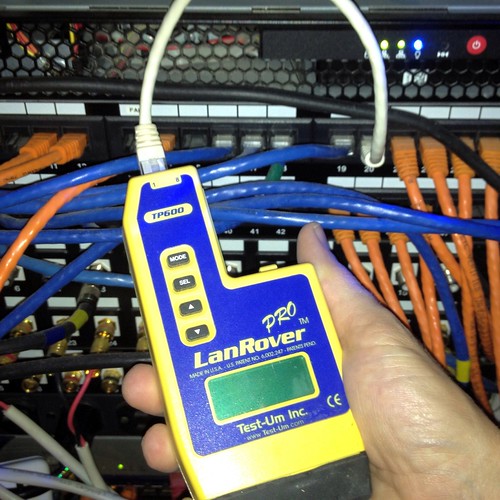Though most of the tools we've covered on Toolbox Tuesday have been geared around woodworking, painting, HVAC, or other items commonly associated with home improvement, today's tool has a far more technical lean to it.
Some time ago we filled you all in on our completely and totally overkill structured wiring projects. We also gave you a glimpse into our even more awesomely nerdy DIY Server Rack, which includes a 48 port patch panel for our home's network.
The thing with this project is that it isn't just about running wire and plugging in components. Running network cable, though relatively easy and completely DIYer capable, requires a certain amount of patience and a collection of job specific tools to do it right.
Remember my mantra, "One new tool for every project?" This mantra is never more true than when you run cat-6 in your home. Though many tools are critical in home network cabling, one tool stands out among the rest in helping me to quickly and easily identify if I've done the job correctly, or the potential issue if I've messed it up (hey, it happens).
The tool I'm referring to is the Test-Um LanRover Pro TP600 Network Tool and Tester. When running network wire you must be sure to make "home runs" (consistent runs of cable from the outlet to a common termination point). There's no splicing in the middle, like with phone or cable wire. In addition, you also need to make sure you aren't kinking or bending your cable too hard, or running it near a significant source of interference, like big fluorescent lights. Once all of your cable is run you end up with a single bundle of wire in the basement (or network closet location), lots of outlets all over the place in the house, and the hope that you've labeled everything accurately and have not damaged any cables, but how do you test this?
This is where the LanRover comes into play. This tool has two components, the main handheld control and a detachable remote tester. This little remote tester is the absolute key to the function of this tool.
After you've punched down and terminated your cat-6 to the outlet ports and patch panel, using a small network patch cable you attach the remote device to one port, then attach the control device to the patch panel, then finally run the diagnostics mode of the tool. If you've done everything correctly and terminated all of the pairs in the proper order at both points, the display will tell you that you have 8 matched pins. But if you've made a mistake, it will flash the pins that are not communicating. And best of all, if you have the wrong cable entirely, the tool will let you know that there's no remote device connected. This is great when you're trying to figure out just which wire you're testing.
Prior to owning the LanRover I had a simple pinout detector that had no remote sensor. The simple tool was almost useless for anything other than testing short runs or patch cables. Once the runs started going from the basement to other rooms in the house, the remote component became key to doing the job right. Best of all, you can even buy individual remote testers so you can test out more than one at a time without having to running up and down the stairs or yelling for Wendy to "MOVE IT...I'M DOOOONNNEEEE!!!!" She's a fan.
So if you're considering a home networking project of any size, be sure to pick up a LanRover tester. It's one of the moderately priced (though still a bit expensive) of the advanced network testers, and I'd be lost without it.
Have you taken on a home structured wiring project? Have any opinions on must have tools for the job? If you haven't, am I inspiring you to tackle something in your house? Come on, do it already, all the cool kids are doing it, what can it hurt?
Did you enjoy reading this post? Want to learn more about our first-hand experiences with other tools, devices or items used throughout our renovation? If so, check out our complete list of product reviews in our Toolbox Tuesday section.
Note: We weren't paid for this review. We simply want to share good products when we see them, and hope that learning from our mistakes can help save you time, money and frustration.

![]()
![]()